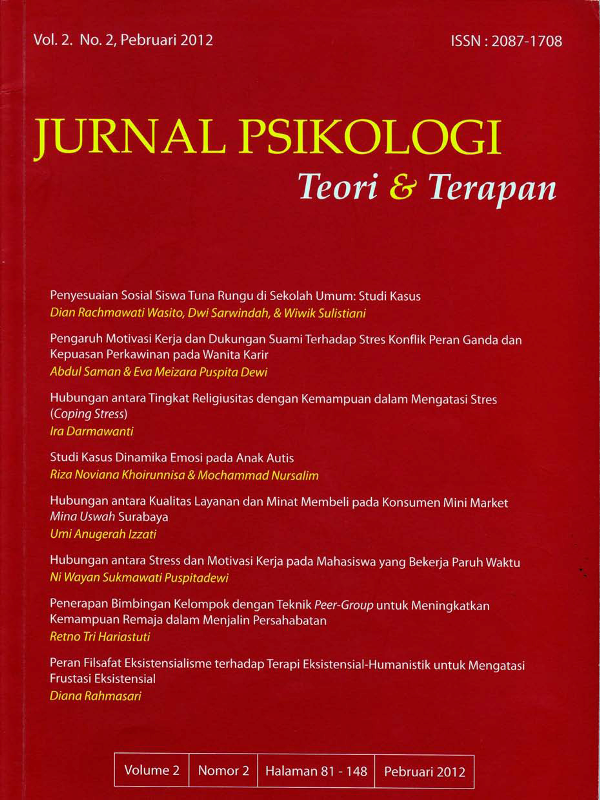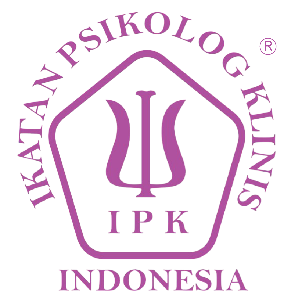Studi Kasus Dinamika Emosi Pada Anak Autis
DOI:
https://doi.org/10.26740/jptt.v2n2.p108-120Keywords:
Dinamika emosi, anak autisAbstract
This study aimed at exploring the emotional dynamics of children with autistic. A qualitative approach with case study method was employed. Two autistic children with average autism severity in Cita Hati Bunda School and Therapy Center for autistic children Sidoarjo were recruited as participants. Data were collected from interviews, observation, and relevant documents. The Plutchiks concept of emotion components, namely stimulus event, inferred cognition, physiological arousal, feeling state, impulse to action, and overt behaviour and effect was used to invoke some psychological insight in the analysis. The study found that the dynamic of emotions that occurs in autistic children was influenced mainly by situational factors. The result suggested that autistic children need more times to perceive the contexts of stimuli. However, this study was not able to explain how these children make meanings of those stimuli.Abstrak: Penelitian ini bertujuan untuk mengeksplorasi dinamika emosional pada anak-anak autis. Pendekatan kualitatif dengan metode studi kasus diguna-kan. Dua anak autis dengan tingkat keparahan autisme rata-rata di Cita Hati Bunda Sekolah dan Terapi Pusat autis anak Sidoarjo direkrut sebagai partisipan. Data dikumpulkan dari wawancara, observasi, dan dokumen yang relevan. Konsep Plutchik tentang komponen emosi, yaitu stimulus event, inferred cogni-tion, physiological arousal, feeling state, impulse to action, overt behaviour dan effect digunakan untuk memberikan wawasan psikologis dalam menganalisis data. Studi ini menemukan bahwa meskipun ketika emosi itu bangkit anak-anak autistik ini tidak mampu mengontrolnya, namun dinamika emosi yang terjadi pada anak autistik sesungguhnya dipengaruhi terutama oleh faktor situasional. Hasil penelitian juga menunjukkan bahwa anak-anak autis perlu waktu yang lebih banyak untuk memahami konteks rangsangan. Namun, penelitian ini tidak dapat menjelaskan bagaimana anak-anak ini memaknai berbagai rangsangan yang mereka terima.
References
Castelli, F. (2005). Understanding Emotions from Standardized Facial Expression in Autism and Normal Development. dalam situs: Sage Publication and National Autistic Society, www.sagepublication.com.diakses tanggal 20 Desember 2010
Davidoff. (1991). Psikologi Suatu Pengantar (Edisi kedua Jilid 2). Jakarta: Erlangga
Greenspan, S.T & Wieder, S. (2006). The Child with Special Needs (Anak Berkebutuhan Khusus).(Terjemahan).Jakarta: Yayasan Ayo Main
Haber & Runyon. (1984). Psychology of Adjustment.Illnois: The Dorsey Press
Maria,Cristina.(2009).http://melaticeria.or.id/index.php?option=com_content&task=view&id=20&Itemid=51. diakses 7 September 2010
Moloeng, J, Lexy. (2006). Metodologi Penelitian Kualitatif. Bandung: PT Remaja Rosdakarya
Neuman, W. L. (2000). Social Research Methods, Qualitative and Quantitative Approaches. Third Edition. Boston: Pearson Education Inc.
Ornstein, R, & Cartensen, L. (1991). Psychology: The Study of Human Experience (3th edition). Sandiego:Harcourt Brace Jovonich Publishers
Peeters, T. (2004). Autisme. (Terjemahan) Jakarta: Dian Rakyat
Plutchik, R. (2003). Emotions and Life. Washington DC: American Psychological Association
Poerwandari, K. (2005). Pendekatan Kualitatif untuk Penelitian Perilaku Manusia. Jakarta: Lembaga Pengembangan sarana Pengukuran dan pendidikan psikologi (LPSP3) Fakultas Psikologi Universitas Indonesia.
Wijayakusuma, Hembing. (2009). Autisme, Hiperaktif dan Solusinya. http://autishembingcenter.com. diakses 6 Agustus 2010
Downloads
Published
How to Cite
Issue
Section
License
Authors who publish in this journal agree to the following terms:
Copyright in any article is held by the author.
The author grants the journal, publication rights with the work simultaneously licensed under a Creative Commons Attribution License that allows others to share the work with an acknowledgment of the work's authorship and initial publication in this journal.
Authors may enter into separate, additional contractual arrangements for the non-exclusive distribution of the journal's published version of the work (e.g., posting it to an institutional repository or publishing it in a book), with an acknowledgment of its initial publication in this journal.
Authors are permitted and encouraged to post their work online (e.g., in an institutional repository or on their website) prior to and during the submission process, as this can lead to productive exchanges, as well as earlier and greater citation of published work.
 Abstract views: 8484
,
Abstract views: 8484
, PDF Downloads: 4822
PDF Downloads: 4822


















